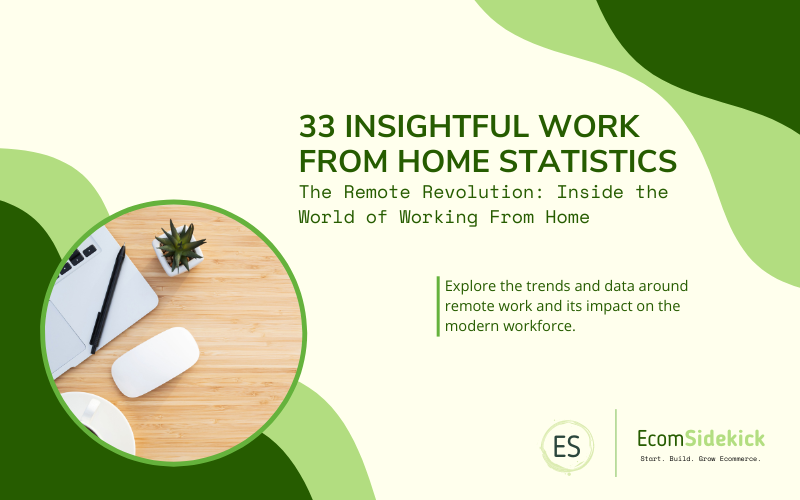With offices out of commission during the Covid-19 pandemic, remote working went from a rare benefit to a standard working pattern. Digital advances made working from home easier than ever, as even traditionally on-site workforces moved online.

But with office workspaces opening up, is there still a place for remote working? We’ve rounded up 33 insightful work from home statistics, to see the role of remote working in the modern business.
Work From Home Statistics: Top Picks
- In 2022, 58% of US workers were offered at least part-time remote working.
- 1 in 3 workers said they’d leave their job if remote working was completely eliminated.
- 90% of remote workers said their productivity was the same as, or better than, working from the office.
- Collaboration is one issue with remote working, as 33% find it hard to work with a team.
- 77% of workers see remote working as an important benefit.
33 Insightful Work From Home Statistics
Working from home has gone from being an anomaly of the workplace, to the new normal. Although not everyone is a fan of home working, it’s undoubtedly here to stay.
1. In 2019, Roughly 9 Million People In The US Reported Working From Home
Work from home is hardly a new trend, but it’s certainly seen a boom in popularity since the onset of the Covid-19 pandemic. In 2019, just 5.7% of people worked primarily from home, which accounted for roughly 9 million people.
2. In 2022, 58% Of Americans Reported Being Able To Work From Home At Least One Day A Week
Numbers of remote workers increased massively due to the Covid-19 pandemic. By 2022, 58% of employees reported being offered part time remote working, with 35% being offered full time remote working.
And more job sectors are offering remote working, from “white collar” jobs, to “blue collar” jobs traditionally associated with on-site labor.
3. 87% Of Americans Take The Chance To Work From Home When It’s offered
Workers aren’t just being offered the opportunity to work from home: they’re taking it. In fact, 12% of employees report that even when offered only part time remote working, they worked from home full time.
This indicates a potentially growing divide between employee and employers. Employees are demanding a flexibility that employers aren’t always willing to give.
4. By 2025, 70% Of American Workers Will Work Remotely, At Least Some Of The Time

Remote working looks set to grow, with many employees now expecting a flexible working arrangement. By 2025, up to 70% of Americans are expected to work from home at least 5 days every month.
5. 1 In 3 Employees Said They’d Leave Their Job Rather Than Lose Work From Home
Post-pandemic, 39% of workers reported returning to the office full-time. However, only 29% actually wanted to be there. A lack of flexibility is one of the causes behind the Great Resignation.
6. 47% Of Employees Report Losing The Commute As Their Favorite Part Of Remote Working
For commuters used to hour-long journeys at the start and end of every day, work from home saved both time and money.
Nearly half of employees said skipping the commute was a benefit of remote working, compared to just 43% who noted the flexible schedule.
7. Employees love the improved work-life balance offered by home working, with 73% seeing a favorable difference compared to office working
46% found remote working gave them more time with their family, while 42% had more time with a partner, and 37% found they had a greater ability to take care of pet(s).
A better work-life balance makes for happier employees, which can lead to the increased productivity often associated with remote working.
8. 74% of CFOs Are Planning A Permanent Shift To Remote Working For Some Employees
For many businesses, remote working was the only solution to an unanticipated problem (the Covid-19 pandemic). However, this trend looks set to stick around.
It isn’t just employees driving the push to remote working. Only 26% of surveyed CFOs said that no employees would be offered work from home post-pandemic.
9. 77% Of Workers Rank Home Working As The Second Most Important Benefit To Them
58% of employees surveyed by FlexJobs stated that they would “absolutely” look for a new job if they were no longer able to work remotely.
A 2022 FlexJobs survey found employees rank remote working as a key benefit when choosing a job. 77% of respondents said it was the second most important compensation and benefit.
10. Women May Prefer Remote Working To Men, As 80% Said Flexible Working Is A Key Factor When Choosing A Job
Remote working appeals to a vast range of employees, but it may be women who feel the benefit of flexible working most.
80% of women surveyed by FlexJobs stated that remote working is one of the most important factors when choosing a new job. In comparison, just 68% of men ranked remote working as a top concern.
11. 70% Of Women Enjoy Not Having To Get Dressed Up For A Job
The rise of work from home might be revealing some unrecognized gender lines in the traditional workspace. 70% of women said a benefit of working from home was not having to get dressed for the office, while only 57% of men said the same.
Remote working can potentially increase workplace diversity, as remote working increases the possibility of hiring sight unseen.
12. Pre-Pandemic, 84% Of Remote Workers Chose To Work From Home Over Another Location
Remote workers might enjoy the flexibility of working outside the office, but prior to the pandemic, most stayed in the home. In 2019, 84% of remote workers operated from home, with the remaining 16% choosing other locations.
But those numbers are changing. In 2022, only 59% wanted to work primarily from home, with coworking spaces becoming increasingly popular.
Productivity And Remote Working: Important Statistics

For many business owners, productivity is a key concern. The traditional 9-to-5, 5-day work week was designed with the intention of increased productivity, but the work from home boom might cause us to rethink exactly how flexible schedules can improve work rate.
90% of employees reported they were as or more productive working from home than the office.
For many worried employers, remote working seemed an opportunity for a reduced workload. However, employees found the opposite was true. 24% of those surveyed said they worked just as well from home, while 67% said they worked even better.
14. 55% Of Employees Claimed To Work More Hours At Home, Compared To The Office
The lack of commute and a quieter environment can boost an employee’s productivity. 55% said they worked more hours on average at home, compared to at the office. Just 12% said they worked fewer hours.
15. And The Link Between Increased Productivity And Work From Home Isn’t New: It Was Observed Even In 2014
Remote working may have grown hugely in recent years, but it’s hardly a new trend. When Ctrip switched to remote working in 2014, they estimated a saving of $1,900 per employee over the course of nine months.
16. 68% Of Workers Found Remote Working Led To Fewer Interruptions, And Increased Productivity
63% of workers felt they had more focused time at home, while 68% enjoyed a quieter work environment.
55% of workers felt avoiding complex office politics helped improve productivity, and 66% credited a more comfortable workspace. These effects were noted even with the stresses of the pandemic.
17. Remote Working Can Reduce Absenteeism And Cut Sick Days
The improved work-life balance of remote working can reduce stress, leading to fewer absences, and reduced sick days.
These benefits are positive for both employees and employers, as it leads to reduced loss of earnings, and more time spent working.
18. 75% Of Managers Trust Their Employees To Work Productively From Home
However, one third say they’d feel more comfortable if they could see their employees.
Even with the proven benefits of remote working, many employees are not yet ready to say goodbye to office working.
A lack of trust is a contributing factor. Despite studies indicating work from home can improve productivity, and remote working necessitates better performance measuring, some feel they can’t trust workers to get on with the job.
19. Traffic Jams Can Cost The US Economy Upwards Of $78 Billion Every Year
Without having to commute, there’s less opportunity for employees to get held up on the way to work.
Traffic jams account for a loss of roughly $78 billion in the US every year. A return to the office could see an increase in traffic, and with it, an increase in traffic jams. For every 1% of vehicles off the road, congestion decreases three-fold.
20. But Work From Home Can Have Its Downsides: 40% Of Remote Workers Say They Struggle To Unplug At The End Of The Day
An increase in productivity and working hours may have many benefits, but it can be a disadvantage for employees who struggle to turn off at the end of the day.
While many employees prefer remote working, it’s important for businesses to encourage a disconnect at the end of the day. Otherwise, expect to see increased levels of burnout among remote workers.
Other Interesting Work From Statistics
Remote working can impact many areas of everyday life, with the ripple reaching everything from global climate change to the growth of internet security companies. These statistics help to create a rounded picture of the impact of work from home.
21. Some Employees Are Willing To Take A Pay Cut To Retain Work From Home
Some employees are so enthused by work from home, they’d be willing to sacrifice some pay for flexible working. 58% of employees would expect a pay rise if they were asked to return to the office, while 48% might not demand more, but they’d expect to do less.
22. However, 78% Of Employees Feel More Included When Working In The Office
One major downside of work from home is the lack of face to face interaction. 78% of employees feel more connected when working from the office. 70% felt it was harder to contribute to video meetings.
However, 71% found it easier to present via video call, rather than in person.
23. 33% Of Workers Find It Harder To Collaborate When Working Remotely
Without an office space, asking and answering questions can become less intuitive. 33% of employees found collaborative working harder when working from home. Instead of face to face conversations, employees find they have to wait for replies to questions.
24. Remote Working Is Helping The Growth Of Online Industries
Remote working may lead to an initial dip in communication, but collaboration tools including Zoom, Teams, and Skype are helping improve conversation.
And other online industries may see a benefit of remote working. The secure web gateway market is set to grow by roughly $11,710 million by 2027, while the Cloud managed services market size is set to expand to $164 billion by 2027.
25. Working From Home Can Save A Company $1,900 Per Employee
Without having to pay for office space and materials, businesses can save money by offering remote working. In turn, employees can save money by eliminating the commute, and moving away from office attire.
26. Remote Working Is Causing People To Move Beyond Commutable Cities
Remote working allows employees to work wherever they have an internet connection. Since 2020, 2.4% of Americans have said they’ve moved because of the benefits of remote work.
28% of employees are moving beyond commutable distances, with 13% moving up to 4 hours away.
27. Remote Working Can Benefit The Environment By Reducing Emissions From The Commute
The value of remote working goes beyond the employee/employer relationship. Sun Microsystems found that when 24,000 workers were offered flexible working, they avoided producing 32,000 metric tons of CO2 in one year.
28. 70% Of Employees Are More Favorable To A Company If They Help Reduce Carbon Emissions
Keeping employees is difficult in the current Great Resignation, but a focus on environmental policies may help boost a company’s image.
29. 75% Of Teleworkers Believe They Can Continue Working If A Disaster Occurred
The Covid-19 pandemic felt like a once in a lifetime moment, but the reality is, we can’t be entirely sure what waits around the corner.
In the event of a disaster, 75% of teleworkers said they could carry on working, compared to just 28% of non-teleworkers.
30. Hybrid Working Is More Popular Than Remote Working

Work from home may have dominated the headlines, but it appears what workers value more is flexibility. 54% of employees preferred a hybrid working situation, while just 37% wanted exclusively to work from home.
However, only 9% wanted to work exclusively at the office.
31. 80% Of Remote Workers Pay For Their Own Internet Connection
A saving for the employer, but a loss for the employee. It can potentially also lead to a reduction in productivity, as employees might stick with a poor internet connection, rather than pay for an upgrade.
32. 45% Of Workers Believe Remote Working Can Inhibit Career Growth
Some employees worry remote working might be a case of “out of sight, out of mind”.
Worries surrounding career growth appears to be a key concern for remote workers, who feel they might be overlooked when it’s time for promotions.
33. Home-Based Workers Are Not A Security Concern, According To 90% Of Those Charged With Security For Large Organizations
Office working might actually be a larger security concern, as they may not be prepared for security breaches.
Whether hybrid, traditional office working, or remote working, security training remains a crucial consideration for businesses post-pandemic.
Final Thoughts
It’s impossible to argue against it — work from home is here to stay. Employees are beginning to demand it, and employers are starting to see the productivity benefits.
However, statistics also indicate that remote working isn’t a perfect solution. A method for better collaborations, and increased employee visibility, is vital.
But remote work can improve work-life balance, save money, and even benefit the environment. As the world moves on from the Covid-19 pandemic, expect remote working to stick around.
Frequently Asked Questions
How Many Workers Now Work From Home?
In the US, 58% of workers are now offered at least part-time remote working, with 35% offered the opportunity to work from home full time. This is a huge jump from 2019, when just 5.7% of Americans worked remote full time.
Will Remote Working Continue?
Remote working looks set to stay, with 1 in 3 employees saying they’d change jobs if asked to give up remote working. However, hybrid working may be the way of the future, with employees (and employers) preferring flexibility.
Does Remote Working Improve Productivity?
Remote working can potentially improve productivity, and rarely seems to damage it. Workers suggest home working offers fewer distractions, and a comfortable environment that encourages productivity.
Remote workers are also more free to listen to music or podcasts as they work, so platforms such as Spotify are gaining popularity. This may increase their mood, but would be difficult in the office.
Paul Martinez is the founder of EcomSidekick.com. He is an expert in the areas of finance, real estate, eCommerce, traffic and conversion.
Join him on EcomSidekick.com to learn how to improve your financial life and excel in these areas. Before starting this media site, Paul built from scratch and managed two multi-million dollar companies. One in the real estate sector and one in the eCommerce sector.

